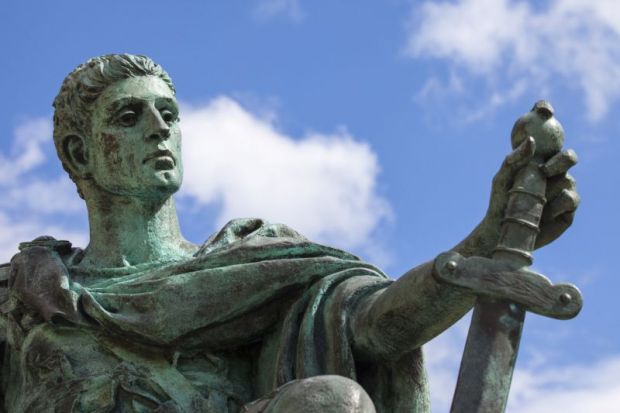Mary Beard has been having a torrid time of it, as you may well know.
She has been Twitter-trolled for defending the well-supported proposition that Roman Britain’s population to some extent reflected the ethnic diversity of the vast Roman Empire as a whole, a legal and economic entity that stretched from Libya to Scotland – from the Lake District to the Middle East.
exactly... my objection is to being called 'bullshitter' 'obese' 'batty old broad' and hopefully victim of 'meme jihad' in course of debate
— mary beard (@wmarybeard) August 6, 2017
She was defending some illustrations in a new school text video that reflected some of this diverse imperial context.
Now, there’s a legitimate argument about racial categories and genetic inheritances and the fact that to be “African” did not necessarily mean to be “black” as we would understand it nowadays with the dubious benefit of subsequent ethnic categories. The skin colour of various people from various parts of this vast domain continues to be contested and there ought to be an acceptable framework for such intellectual contestations. The Mary Beard Twitter storm is no such acceptable framework.
In the meantime, I don’t pretend to be a Roman historian – not even at very specialised parties. Mary Beard is someone who I enjoy as a writer and a historian, and what she says is supported by other sources that I’ve read.
Oddly enough, I’ve been aware of cognate debates involving the far more recent past. Doctor Who, from the David Tennant era (The Shakespeare Code) to Peter Capaldi (Thin Ice), has started to depict 16th- to 19th-century England (especially London) as a rather ethnically diverse environment. And I’ve encountered a degree of scepticism and unease online in certain quarters as a result.
Since this debate strays into territory that I’m supposed to know something about, then I feel I that can say something. Estimates of the number of dark-skinned people of African origin in London by 1800 are constantly being revised upward. Their numbers were definitely to be measured in the tens of thousands.
Yet some are still unhappy, claiming that it is a distortion of history to claim that a London crowd at the 1814 Frost Fair would have enjoyed the diversity that we see on screen.
Well, there are various ways of dealing with such comments calmly. One is to concede that although the ratio of darker faces does not offer a mathematical reflection of the ethnic proportions of London’s entire population at the time – no crowd did, or does. Crowds of people are not organised on a quota basis, and on any occasion particular communities are going to be over-represented in public gatherings.
You can also point out that if a particular historical reconstruction or dramatisation appears to “overdo” the diversity, then this is a very, very mild corrective measure considering the complete airbrushing of certain populations from film and television dramatisations over the past century.
If you’re feeling bold, you can also ask certain people if they’ve commented with at least equal vehemence about this airbrushing effect. There were tens of thousands of black people in London at the time of the Frost Fair of 1814. Lots of them would have enjoyed it. What is so politically disturbing (or disturbingly “political”) about actually seeing them?
Similarly, casting decisions regarding a black lesbian companion and a female Doctor are treated as “political” in ways that the exclusive casting of heterosexual companions, or an endless sequence of white male Time Lords is not political. To be white and male is “normal” and not political. To represent other ways of being human is a surrender to “political correctness”. Indeed, the horribly successful phrase “political correctness”, which exists only as a bogey term dangled by those who abhor it, demonstrates the political power of being able to assert what is and is not “political”. I am normal. You are “political”.
Mary Beard was, of course, assailed by the hedge-fund manager and eclectic polymath Nassim Nicholas Taleb, who tweeted that Beard’s claims proved that scholarship was dead in the UK and complained about “the politically correct Gestapo” being at work.
Wusses in UK intelligentsia who hate the Pol.Cor.Gestapo yet are afraid to speak.
— NassimNicholasTaleb (@nntaleb) August 5, 2017
They study in detail Ceasar, Hanbl, but they are wusses.
Those who are terrified of the thing they call “political correctness” are never shy about dragging in the Nazis.
Those who trailed and trolled in the wake of Taleb were driven not by scholarship but by emotion. Why do people want to affirm an all-white Roman, Renaissance, and Georgian England? What is it that people fear and what is it that they think they are defending? Why...are they “bovvered”?
Of course, for many such people, any representation would have been over-representation.
I think that what many of those directing tweets at Professor Beard want to feel is that whiteness is a secure point of origin. It’s important for some people to feel that even London was once ethnically “secure” and homogeneous.
The idea that there were people from North Africa living in England at a time when there were hardly any Saxons there is one that is not only to be challenged empirically, but stamped on vehemently. It cannot be entertained. It cannot germinate. Mary Beard must not only be refuted but crushed.
Conrad Brunstrom is a senior lecturer in English at Maynooth University. This is an edited version of an article that first appeared on his personal blog, Things I Never Thunk Before.
Register to continue
Why register?
- Registration is free and only takes a moment
- Once registered, you can read 3 articles a month
- Sign up for our newsletter
Subscribe
Or subscribe for unlimited access to:
- Unlimited access to news, views, insights & reviews
- Digital editions
- Digital access to THE’s university and college rankings analysis
Already registered or a current subscriber?




